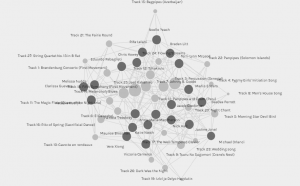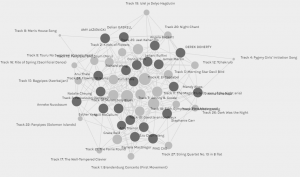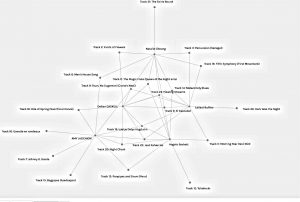I took your suggestions literally and tried to ‘break’ Paladio (because I knew I supposedly couldn’t), and quickly realized that I was seeing a set of 21 students, who were represented as nodes, of much the same size, and that these ‘sizes’ were due to the number of links or connections (edges) they had to certain songs from the Golden Record. In this representation, the edges, and all the written information made it difficult for me to interpret much beyond the fact that my name was no where in there and the songs that were represented as the largest nodes (with the most edges) were not on my curated list, so I spent most of the week thinking that my song choices were so ‘unconnected’ to other students in the class, that I must have absolutely nothing in common with them or that the criteria I used to select my songs extremely different from any one else’s! Also, I believe this must be a type of unweighted network, similar to what we saw within Owen Cornec’s Wikigalaxy, though in the Paladio visuals, the links don’t bring you anywhere.
Eventually I realized I was seeing the visualized representations of song choices from Section A of this course, and I thought maybe you had given us links to data from a group that didn’t include our own choices (to be more objective?).
Figure 1 below shows a visualization of Section A students visualised as curators with edges/links highlighted this section’s chosen songs from the Golden Record. I did not find this visual very helpful because there were too many detailed crowded on top of each other. I could mostly see the songs that had fewest connections (links) in comparison to the songs that were chosen by more of the curators. Figure 2 was more helpful for me to see all the Section A curators visualized as nodes of five different communities of various sizes, again with edges highlighted to show the connections to certain songs. Both the communities and the songs are visualized as larger if there were more edges/links to them. Based on this analysis, this section seemed predisposed to Beethoven’s 5th symphony, the percussion track from Senegal, the American rock & roll song Johnny Be Goode and Jaat Kahan Ho, the Indian raag piece with voice and sitar.

Figure 1
.  Figure 2.
Figure 2.
After staring long and hard at many different visualizations, I was ready to write up my analysis, when suddenly, yesterday, I reopened Paladio and somehow now was able to just see the group of students in my section (B). All of a sudden, I existed and my criteria for song choices was actually linked to others – I was represented!
Figure 3 below shows a visualization for Section B, with the same settings in Paladio that created the visualization for Figure 1. Again, it is very crowded with details, but I can see the outliers (Men’s House Song and Pygmy Girls’ Initiation Song with only two edges) as well as some familiar more ‘connected’ songs (El Cascabel and Melancholy Blues with 14 edges, followed by Beethoven’s 5th Symphony, Johnny Be Goode, the Magic Flute (Queen of the Night aria), the Senegalese percussion piece and Jaat Kahan Ho with 11 edges each). It seems like the Section B group was predisposed to Mexican Mariachi music and Louis Armstrong’s famous blues piece with no vocal singing. Both of these pieces have strong trumpet components, though the Mariachi is also a group singing piece with various stringed instruments together with the trumpet (and flute?).
 Figure 3
Figure 3
Within the Section B data, what I found most useful was to start to look at the choices made in the small ‘community’ my song choices had placed me in. Figure 4 below shows these details. Based on the strength of (or number of connections to specific songs on the Golden List), I was in a community with four other members: Leilani Ruffini, Natalie Cheung, Amy Jazienicki and Angela Becket. Based on this visualization (and the use of the facet filter to see song choices within a group), I could see that this community was created based on the strength (number of links) to four particular songs:
- El Cascabel
- Melancholy Blues
- Jaat Kahan Ho, and
- the instrumental Chinese piece, Flowing Streams.
Interestingly, the Outliers in this community (Track 12, the Ukrainian choir piece and Track 7 Johnny Be Goode, for example), were actually popular (connected) tracks for other groups (in Section A and B).
 Figure 4.
Figure 4.
Why are our responses similar overall in Section B (choosing Mariachi and Blues music for the most connections), and why did we not choose some other songs (like the outliers in my group)?
These visualizations reflect quantitative data only: the number of links or edges make up a community. In order to find out the reasons behind these choices, I did not find it meaningful to make assumptions beyond, it seems like we like trumpets in Section B, while in Section A, their top choices were non-vocal: both Beethoven’s 5th symphony and the percussion track from Senegal.
But how were these choices made and what criteria were used to make them? To find out this information, a visual like this can not help us. We must go to the qualitative data, the criteria and justifications described in Task 8. I spent some time reviewing this information, first for my community, and was able to see how each of us had our own interpretation of how to fulfill the instructions for this task. Leiliani chose songs based on culture and instruments used, as well as genres. Natalie focused on what she described as ‘overall coherence and sophistication’, for each track to be ‘like a painting’, but did not mention culture as a criterion. Amy had stressed that she wanted to highlight tracks that were ‘exclusively instrumental’ as well as those with vocals – and for her list to span continents, cultures, countries, genres, moods, tones and ‘types of stories’. I noticed that her list had 6 instrumental pieces and 4 vocal pieces. Angela had descriptions for each of the songs she chose, and though she explained her criteria as being partly driven by representation of culture and place (American), she also seemed to be making choices based on feeling (many references to how the pieces made her ‘feel’) and memories she had. She articulated a similar concern that I had when I was making my choices: there were too many western-European examples, so it seems that both of us created ‘null choices’ for the other composers, and limited ourselves to choosing just one. We happened to choose the same one, though reading through Angela’s justification for why she chose Mozart’s ‘The Magic Flute: Queen of the Night aria’, we made our choices based on different reasons. I chose the piece because I felt Edda Moser’s voice was being used like an instrument, which is something so different from the other classical song choices.
Political implications of such groupings considering what data is missing, assumed or misinterpreted
I also read through the qualitative data for other classmates, and realized they were making decisions based on criteria that were extremely different from my own: only choosing instrumental pieces, or only vocal, or based purely on how the songs made them feel or if their children liked the sounds or not. Many were trying to think of what an alien could understand (maybe not voices or maybe only voices?). I was making choices to include more Asian music and made it a point to include the Navaho Song of the Night since I was very aware of what was not included in the Golden Record. I didn’t read many other classmates saying exactly the same thing, but absence of evidence isn’t evidence of absence! Some were reflecting on their own choices being quite Euro-centric, so there was some awareness.
Even by reading the qualitative data, I was unable to really understand why people did not choose some songs over others. This has implications for the concept of ‘predictability’. If a company like Google is going to try to group people together based on quantitative choices or web navigation patterns, which are meant to demonstrate our preferences and behaviours, there are dangers that we will only be offered or assisted with a certain part of the web that has been pre-determined as the ‘best content’ or ‘best message’ for us based on our past choices. Obviously, we have already seen problems with this type of grouping in places like Facebook and Instagram where echo chambers of information can exist or negative behaviours can be facilitated or even encouraged. I have consciously limited my access to Facebook since the last US presidential elections last year because I feel manipulated and annoyed by some of the ads and content provided on my ‘feed’, but now that Facebook is the ‘meta’-verse, I think that critical thinking and avoidance of some social media platforms will only get me so far from these predictive algorithms.
natalie cheung
December 7, 2021 — 11:27 pm
Hello Delian! First of all, I really appreciate the thoroughness and depth of your observations on our community! Thank you for sharing your insight on all the little details of the visualization and taking us through the step-by-step process of your analysis. I also read more into what the other members in our community wrote for their Task 8, hoping that I could gain more insight on why we were grouped together, and I cannot agree more with your observations.
The possibilities for criteria selection were endless and subjective, so I was impressed that the visualization captured us all! And on a side note, I was also confused when I first noticed that the visualization did not contain my name or some our classmates’. I was worried that I somehow did not make it because my selection was too out of range! Later I found out from Prof Peña that the link given to us was indeed for a different section.
I really appreciate that you took the time to read through our group members’ and classmates’ criteria in the previous task, which helped generate your insightful comparisons and conclusions. As you mentioned, the visualization reflected the quantitative data only, and nothing else beyond our names and song choices. I thought that there must have been some distinction that we have in common (other than similarity of the results), for us to be brought together. While I observed that our values did not seem to fully align, you also made an excellent point that “absence of evidence isn’t evidence of absence.” I cannot agree more, and your point makes me rethink my own conclusion. It’s always a challenge to avoid assumption when working with data, and it’s easy to become just a number.
I like your statement about the predictability factor of the web. We just can’t avoid the content! Whether we clicked on something out of curiosity or accidentally, that decision is already being channelled into our individual web patterns and generated into our results. I remember it would take so long to finally stop seeing something I did not want to see on my feed, just because a friend sent me a link to it once. Nowadays, I’m more mindful with what I click. Circling back to your previous points, it does seem like web algorithms are showing us already predicted content based on its mere assumptions of us (as quantified data), without learning about why.
Thank you again Delian, for your fantastic insight and perspective! It definitely made me think more about how the web works.